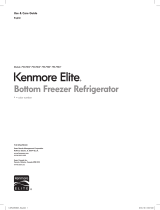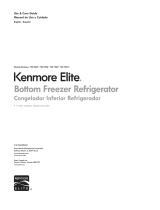
Unpacking the Refrigerator
Choosing the Proper Location
Flooring
NOTE
WARNING
WARNING
Ambient Temperature
Use two or more people to move and install
the refrigerator. Failure to do so can result in
back or other injury.
The refrigerator is heavy. When moving the
refrigerator for cleaning or service, be sure to
protect the floor. Always pull the refrigerator
straight out when moving it. Do not wiggle or
walk the refrigerator when trying to move it,
as floor damage could occur.
Keep flammable materials and vapors, such as
gasoline, away from the refrigerator. Failure to
do so can result in fire, explosion, or death.
Remove tape and any temporary labels from your
refrigerator before using. Do not remove any
warning-type labels or the model and serial number
labels.
NOTE: Remove protective film on doors before
plugging in the unit (on some models).
To remove any remaining tape or glue, rub the area
briskly with your thumb. Tape or glue residue can
also be easily removed by rubbing a small amount of
liquid dish soap over the adhesive with your fingers.
Wipe with warm water and dry.
Do not use sharp instruments, rubbing alcohol,
flammable fluids, or abrasive cleaners to remove
tape or glue. These products can damage the
surface of your refrigerator.
Refrigerator shelves are installed in the shipping
position. Please reinstall shelves according to your
individual storage needs.
The refrigerator should always be plugged into
its own individual properly grounded electrical
outlet rated for 230 V~50 Hz, AC only, and fused
at 15 A.
This provides the best performance and also
prevents overloading house wiring
circuits
which could cause a fire hazard from overheated
wires. It is recommended that a separate circuit
serving only this appliance be provided.
To reduce the risk of electric shock, do not install
the refrigerator in a wet or damp area.
To avoid noise and vibration, the unit must be
leveled and installed on a solidly constructed floor.
If required, adjust the leveling legs to compensate
for unevenness of the floor. The front should be
slightly higher than the rear to aid in door closing.
Leveling legs can be turned easily by tipping the
cabinet slightly. Turn the leveling legs to the left to
raise the unit or to the right to lower it (See Leveling
section).
Installing on carpeting, soft tile surfaces, a
platform or weakly supported structure is not
recommended.
Install this appliance in an area where the
temperature is between 55 °F (13 °C) and 110 °F
(43 °C). If the temperature around the appliance is
too low or high, cooling ability may be adversely
affected.
Too small of a distance from adjacent items may
result in lowered freezing capability and increased
electricity consumption charges. Allow at least 24
inches (61 cm) in front of the refrigerator to open
the doors, and at least 2 inches (5,08 cm) between
the back of the refrigerator and the wall.
Measuring the Clearances
2” (5,08 cm)
24” (61 cm)
9 INSTALLATION
ENGLISH





















